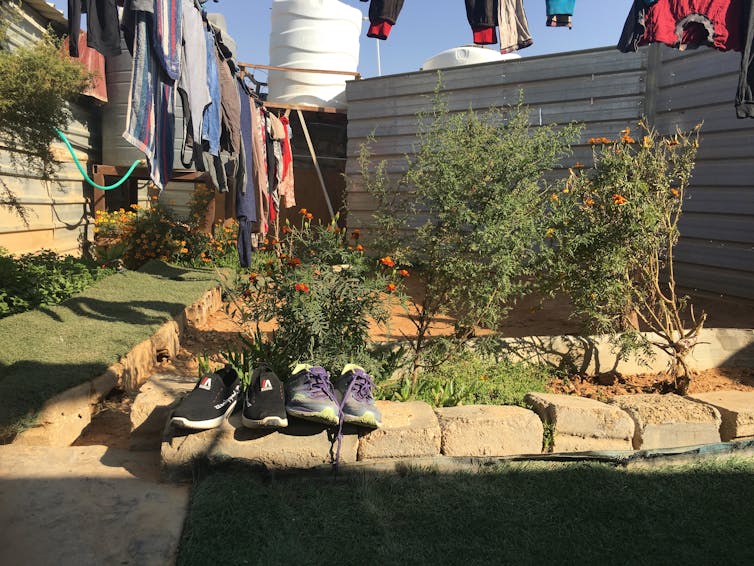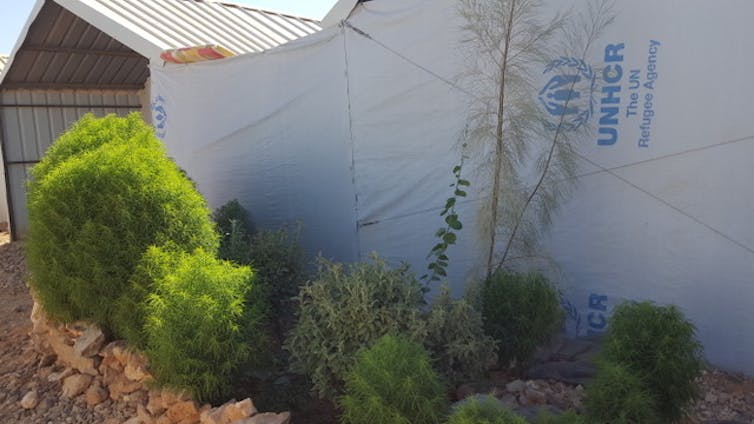For the last few years, Yasmine Shamma has been interviewing Syrian refugees about their experiences of displacement. One of the things that struck her the most is the common desire to create a garden – and that talking about gardens breaks down barriers and allows neighbours to connect with each other in difficult times.

During lockdown, my family’s cul-de-sac became our universe. Suddenly, our neighbours became the only people we’d be guaranteed to see in the flesh for the foreseeable future, and the “good fences” that are known to rigidly force “good neighbours” came down, replaced by authentic forms of humanity and connection.
One such form of connection was in gardening. It proved an easy topic to cultivate, and return to, over the weeks that piled on top of one another. Tim, a neighbour whose name we hadn’t known until lockdown, offered our toddler daughter a (distanced) fistful of fuchsia flowers after she’d pointed to them and called them pretty. Over the following weeks, an exchange of courgette plants and Sweet Williams proceeded, and we now have both a friend, and a colourful garden.
I wonder what will happen to this garden. Gardens simultaneously planted throughout the world’s backyards, balconies, and urban walls – will they, like other momentary obsessions responding to news cycles, be abandoned? And what about the birds, globally united in their sudden singing? What will happen to the lettuce on my windowsill, the tomatoes on the balcony, and the Sweet Williams in the garden, now that the world is waking up and turning the office lights back on? We can only focus on one thing at a time.
The gardens we so furtively grew, and might furtively abandon, remind me of other gardens planted in periods of waiting. For the last few years, I have been interviewing Syrian refugees about their experiences of displacement. One of the things that has struck me the most is the common tendency to garden.
At Zaatari Refugee Camp in Jordan, where I have conducted much of my research, small bushes of “muknisit al janna” (a tumbleweed) grow everywhere, and seeds have been planted in hope of growing tiny Persian cucumbers. I’ve found a willingness to cultivate the land that is generative in and of itself. Gardens need this willingness to care for the land to grow.
The tendency to garden in refugee camps is so ubiquitous that the UN has implemented a training programme in hydroponics, which has already educated over 600 people. I would guess that around a third of the refugee homes in tents and caravans which I visited had small gardens planted next to them. These gardens suggest that the space of home is not necessarily confined to the uniform dwellings made of sheet metal which refugees are allocated, but to the earth on which the dwelling sits.

The refugee garden is an especially noteworthy feat in Jordan, where the presence of a garden is remarkable in itself. Jordan is an arid, desert country, and refugee camps are set in its fringes; on abandoned olive groves (as in Zaatari), and or explicitly delineated “desert” lands (as in Azraq, another refugee camp in Jordan). It is a shock to find a garden in a desert, but a special one to find handfuls of them in the refugee camps, because water, like other resources, is scarce and rationed. Indeed, the pressure of the refugee population’s existence in Jordan is acutely felt in the pressures on its already limited natural resource of water — a topic rife with its own political history.
When I asked refugees about their makeshift (and often illegal) gardens, pride coloured their responses. One Syrian refugee, who I think of often, planted a peach tree from the pit of a peach offered by a relief worker on her first day in the camps. She did so despite the implications that such planting held: of intending to stay awhile. Though the refugee “waits”, as Valerie Luseilli puts it in her recent acclaimed novel Lost Children Archive, they also find quiet, useful, ways of marking time in waiting. Their gardens do so, measuring time as a slow, seasonal clock.
On my most recent visit to Zaatari, I was told that I would no longer be permitted to ask refugees about the past (“it’s too difficult” said one of the armed officials) or the future (“it’s too difficult,” he repeated). I was left, then, with the present to deal with. I could ask about the here and now only if it was a here and now void of then and if or when.
Not unlike those of us who have recently experienced waiting under lockdown, the refugee who waits, gardens. And not unlike the chit-chat I made so recently with my own neighbours, I tended, on this recent visit, to resort to talk of the gardens around the tented space which these refugees so graciously welcomed me (and my new entourage) into. I was left with, it seemed, a single topic for discussion: just as my daughter made easy talk with our neighbour about his fuchsias, I asked Um Mohmmad, for example, about the small tumbleweed garden that framed her caravan’s entrance: “Is this your garden? Did you have a garden in Syria?”
“Yes. It’s a plant called Muknisit il Janneh. And yes, we used to have olive trees back in Syria outside our house. This plant grows quickly.” There is irony in the plant itself, “summer cyprus”, or in Arabic, “heaven’s sweeper”: it is an invasive tumbleweed that can grow in the most arid of conditions.
“I thought of planting pumpkins,” I said to Tim recently, a manageable way of saying that I wonder if lockdown will last through an autumn harvest. That was last month. We now sit on what feels like the other side of lockdown, while the refugee still sits in her tent, her peach tree beside her offering age-old, beyond human, respite — one of the few forms available to her, and planted herself.
Yasmine Shamma is a lecturer in modern and contemporary literature at the University of Reading. She is creating an online archive of stories and descriptions of homes that have been lost and found by refugees of the recent Syrian crisis: Making Home Away.
